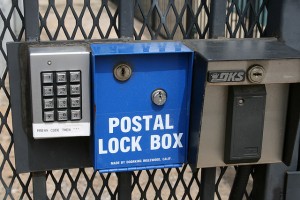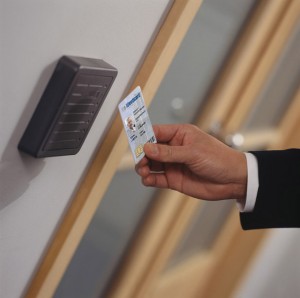Protecting your business is a top priority. You’ve done your homework, found a security systems professional, and are ready to customize a security system that fits your needs. When browsing the vast array of available security system options you’ve probably come across the phrase access control. What is it, and does your business need it? In general, access control is exactly what it sounds like, it grants, denies, or limits entry and sometimes exit to an environment. To get a little more specific, “Access control systems are physical or electronic systems which are designed to control who has access to a network” (wisegeek.com).
One of the most obvious and simplistic examples of access control is a door with a lock and key. Being a business owner, you know it may take more than a door to protect you, your employees, and company assets from potential crime and danger. Including an access control device, whether it’s a proximity card reader, keypad with password, fingerprint scanner, or a combination of these, as part of your comprehensive security system can help prevent costly and disastrous interruptions in your day-to-day business. It can also keep you informed on who is coming and going, where your employees are going throughout the day, limit access to specified areas, and keep unauthorized people out. Security systems companies like Perfect Connections, Inc. can provide a variety of access control solutions to better secure the integrity of your business.
Types of Access Control
As previously defined access control can consist of physical or electronic systems. Today, many systems are a combination of both. There are a few basic types of access control systems, that when used in conjunction with monitored alarms and surveillance can provide comprehensive protection for your organization. Locks, readers, keypads, cards or fobs, and biometric scanners are some of the most common forms of authentication devices. So what are they, and how do they work?
Locks
You’re probably aware of the general function and parts in your average door lock. Typically there is a knob or lever that when turned releases the door latch from the strike plate on the wall. Today, there are more advanced locking mechanisms that can provide better protection for your business. Two of the more commonly known locking mechanisms are magnetic, or maglock, and electric strikes. Magnetic consists of an electromagnet and armature plate; it works by a current passing through the magnet attracting the armature plate creating a locked position. Maglocks are a durable and fast acting solution. Electric Strikes either accept alternating or direct currents. Like a standard strike, they accept a locking latch. Unlike a standard strike, they can be configured to open without the use of a lever or knob turn, and are controlled by electrical currents. These types of locks can be triggered by a readers that accept cards, key fobs, or keypads with passcodes, and biometrics. It is important to remember that where you have locking doors, gates etc. egress and fired codes must be taken into account. To be sure your locking mechanisms are code compliant, be sure to have them installed by a security systems professional.
Readers
According to William Deutsch i n regards to EAC (electronic access control), “In a modern EAC system, the readers are designed to recognize codes (something you know), credentials (something you have), or biometrics (something you are).” Readers take the given information from the potential entrant and either confirm identity by allowing access or deny it for being false or incorrect. They are the means by which information is processed and they can be installed on the exteriors and/or interiors of a facility.
n regards to EAC (electronic access control), “In a modern EAC system, the readers are designed to recognize codes (something you know), credentials (something you have), or biometrics (something you are).” Readers take the given information from the potential entrant and either confirm identity by allowing access or deny it for being false or incorrect. They are the means by which information is processed and they can be installed on the exteriors and/or interiors of a facility.
There is a range of readers available including proximity readers and smart card reader; hiring a knowledgeable and informative security systems professional like Perfect Connections, Inc. will help you better assess your facility’s needs. You may think the construction of your facility wouldn’t allow for the installation of a reader. For example, if you have a fully glazed entry, where would it go? Luckily, readers can be applied to architectural elements that are as minimal in area as window/door mullions. Don’t let the architecture of your facility dictate your security needs. As with any system, nothing is perfect; if someone were to steal a key fob and hack a PIN, the reader will not know the difference, and the intruder will gain access. This is why having a comprehensive security system that includes surveillance and monitored alarms in conjunction with access control is best.
Keypads
Keypad technology typically consists of a small mounted panel that requires a password, PIN, or code, that when entered correctly, unlocks or grants access to electric or magnetic door locks, gates, and/or security systems. This method of identity validation is simple, economic, keyless, and not uncommon. The benefits of a keypad they can easily be recoded, they can be standalone or tie into central control stations to protect multiple entry points, and they will help deter opportunists. Unfortunately, they are not infallible. Codes, passwords, and PINs can easily be shared, and if there is no protective housing for the keypad, onlookers can easily view a code being entered, or see wear and tear on the buttons or screen that are used most (Dan M. Bowers). Used by themselves can leave a facility susceptible to outsider access, but used in combination with other technologies like card readers, key fobs, and/or biometrics will increase their effectiveness. Combining the keypad with another verification control can be called “two factor authentication,” and it’s more secure than the keypad by itself.
Access Cards & Key Fobs (“Credentials”)
Access cards and key fobs also commonly referred to as “credentials,” are a popular security measure for many businesses. Access cards or RFID (Radio Frequency Identification) cards contain specific information that is transmitted to the reader when within a given boundary. Sometimes the cards, which are typically the size of a standard credit card, have to be held to or tapped on the reader, or they can be set up to read the contained information from a specified distance. The same type of information is stored and conveyed by a key fob key fob which is usually molded from plastic or resin, and is small enough to fit on a keychain. This is a more secure option than the keypad by itself, as the cards and fobs are not easily replicated. However, theft or loss of a card or fob can be problematic. Just as with the keypad, including layers of protection through a comprehensive security system can make all the difference.
Biometrics
What is biometrics? “Security Biometric is the science of using physical characteristics (fingerprints, eyes, hands) to identify a person and some of the products used in this system include fingerprint readers and retinal scanners.” While this type of technology may seem a little unconventional when it comes to access control, its presence is becoming more evident. The most common applications being fingerprint readers and hand geometry scanners. The benefits of a biometric system include never forgetting the item that will grant you access because it is part of you, and it’s harder to forge. One of the major drawbacks of a biometric system is the cost. Also, once the data is collected from an individual and stored, it can’t be changed because it so unique. Biometric security is controversial topic for many as it can be perceived as an invasion of privacy. While it may be considered controversial to some, it can provide the necessary means of protection for others.
What Are You Doing To Control Access?
Whether you’ve been considering controlled access to your facility for a while, have an old system in place, or this is completely new territory for you, don’t wait another minute! Contact a trusted security professional at Perfect Connections, Inc. to help guide you through the process. From an initial assessment to final installation, you can rely on our exceptional team of security experts that has provided service to Northern and Central New Jersey for decades.
If you live in Central or Northern New Jersey and would like information on any of the topics discussed above, please call 800-369-3962 or simply CLICK HERE.
Image Credits: Image #1 by 7263255-Flickr-Creative Commons, Image #2 by IDenticardImages-Flickr-Creative Commons
